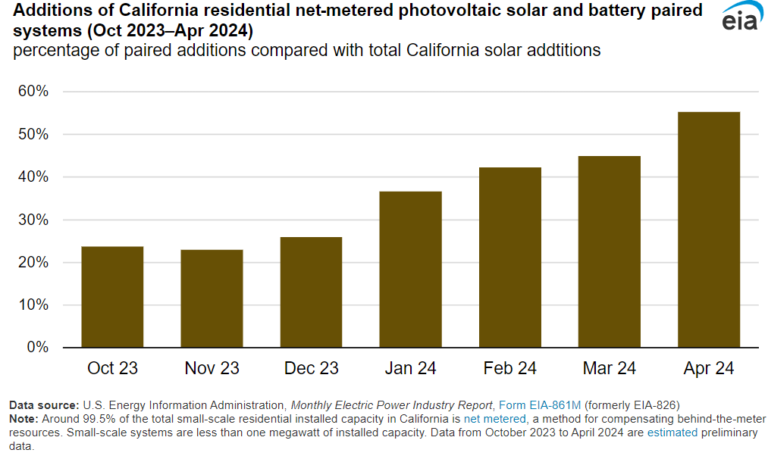Falling battery costs, changing regulations and interest in energy independence are driving an increased number of battery connections at residential solar projects in California.
The U.S. Energy Information Administration said in its monthly electric industry report that battery use is increasing among solar customers in California.
As of October 2023, approximately 20% of California solar buyers chose to include a battery energy storage system in their installation. In April 2024, that number increased to more than 50%.
The change to battery-powered systems is largely due to the transition to Net Energy Metering 3.0, a regulatory structure that reduced the amount customers were paid for sending solar energy directly to the grid. Because of one the hourly mismatch between peak solar energy production and peak electricity demandregulators have changed offset rates to emphasize storing and transmitting solar-generated electricity when it is needed most.
A battery connection rate of 50% or more is a significant change for the state’s solar industry. Solar plus battery systems make up approximately 9% of all installed net residential metering capacity in California. More than 40,000 new systems were added between October 2023 and April 2024, accounting for 232 MW of new battery storage capacity in the state, EIA said.
Although NEM 3.0 achieved its intended effect of encouraging more battery installations, the regulatory decision was unpopular with solar advocates. The change increased the overall sticker price for installing solar, and while you get the added benefit of battery backup during power outages, the amount of time it takes to break even on a solar investment is California increased. This has led to a decline in installations, with the first quarter of 2024 having the lowest installed capacity in a quarter since 2021, with just over 300 MW of solar installed.
California now has more than 12,000 MW of installed solar capacity in residential net metering systems smaller than 1 MW. Residential installations account for more than 70% of installed net metering capacity, and approximately one-third of total installed solar capacity in the state.
“Our data shows that 83,376 new net-metered residential photovoltaic systems were installed in the third quarter of 2023, compared to 70,152 systems connected under the old NEM 2.0 rule during the same period in 2022. However, we cannot distinguish between the systems that are assigned to NEM 2.0,” EIA said.
An additional 46,631 systems were installed in the first quarter of 2024. Since January 2022, an average of 21,000 solar systems have been added every month.
This content is copyrighted and may not be reused. If you would like to collaborate with us and reuse some of our content, please contact: editors@pv-magazine.com.
Popular content



